#indian comics publishers
Text
ब्रेकिंग न्यूज़: कैप्टेन व्योम की वापसी! (Breaking News: Captain Vyom Is Coming Back!)
ब्रेकिंग न्यूज़: कैप्टेन व्योम की वापसी! (Breaking News: Captain Vyom Is Coming Back!)
#BreakingNews
#CaptainVyom
#MilindSoman
#Comics
#MovieFranchise
#DiamondComics
#DDNational
#TheSkyWarrior
#Shaktimaan
#ComicsByte
#ComicsNews
खबर है धमाकेदार, बेहद दिलचस्प और शानदार! शक्तिमान के तीन फिल्मों की सीरीज के बाद अब टीवी का एक और प्रसिद्ध नायक फिल्म, वेब सीरीज को लेकर बहुत जल्द आने वाले हैं एवं वो नायक हैं कैप्टेन व्योम। जी हाँ दोस्तों दिल्ली दूरदर्शन पर नब्बें के दशक में शक्तिमान के साथ-साथ एक और नायक दर्शकों का चहेता हुआ करता था, विज्ञान और साइंस फिक्शन के तड़के के साथ इसे लोगों का भरपूर प्रेम मिला एवं इसे भारत का देसी स्टार…

View On WordPress
#Awesome Nineties#Breaking News#Captain Vyom#Comic Books#Comics#Comics Byte#Comics News#DD National#Diamond Comics#Indian Comics Publishers#Indian Origin#Milind Soman#Movies#Sky Warrior#Super Hero#Web Series
2 notes
·
View notes
Text
Meet The Art Team

Hello Kinfolks!
I've been really looking forward to this post for a while, and it's now time to unveil the art team I've assembled to put this project together! They're some heavy hitters that y'all ought to recognize, so without further ado let's meet them!
Mx. Morgan (They/Them)

Tumblr
Mx. Morgan G Robles (they/them) is a freelance artist and illustrator based in Seattle, Washington. Their work is best known for its use of macabre themes, animals, and nature. They use these themes to explore mental illness, gender identity, or simply to make neat skulls.
They're known for producing book covers for several major publishers, and they've been brought in to design our book covers as well. In addition, they've developed a number of inside pieces as well!
Dogblud She/Her

Tumblr
Dogblud (she/her), is a Midwestern cryptid working as a freelance artist and writer. Her work is near-exclusively sapphic, centering primarily around werewolves, werebeasts, and their strong thematic ties - horrific or otherwise - to all forms of womanhood.
A long-time fan of Werewolf: the Apocalypse, she's joined our team to produce all of the tribe artwork for the book, in addition to a number of other contributory pieces!
Meka (Any Pronouns)

Tumblr
Meka is a Scottish comic artist with a flair for the dark and extremely bloody and a long-standing love of monsters and what they let us all explore-- for better and worse. Vehemently underground, they build stories about horror, grief, depersonalisation, and the isolation that comes with being just a little too weird and too angry to swallow whole. Art and catharsis go hand in hand, as far as she’s concerned.
In a throwback to the original game series, Meka has joined to produce a 22-page fully illustrated comic for the series entitled Cracking the Bone. A postgraduate in traditional comic artistry, we're extremely fortunate to have them on the team.
M.WolfhideWinter (He/Him)

Tumblr
He is a part-time freelance illustrator from Scotland. His work is heavily inspired by the rugged terrain (and rain) of Scotland with a focus on werewolves inhabiting the wild landscapes both past and present. He explores themes of mental illness, societal stigma, dark folklore, and sad werewolves in the rain.
WolfhideWinter has joined our team as our monster-maker, dedicating their time towards depicting our primary antagonists of the garou: The Black Spiral Dancers, and the Wyrm's brood! We can hardly think of a body horror artist more fitting for the role.
----
As a final addendum, we have an additional writer that's joined the team at the last minute.
J.F. Sambrano (They/He)
Patreon
J. F. Sambrano is an author of horror and (urban/dark/depressing?) fantasy and an advocate for indigenous rights. He lives in Washington (the state) and is originally from Los Angeles (the city); the differences are staggering but the ocean and the I-5 are the same. He is Chiricahua Apache (Ndeh) and Cora Indian (Náayarite). He may or may not be a believer/practitioner of real world magic. If he were, he would not be interested in your hippy-dippy, crystal swinging, dream-catcher slinging garbage.
But magic is real, let’s not fuck around.
Beloved Indigenous World of Darkness author J.F. Sambrano is joining our team to depict the Bastet in the Dawn Tribes! A friend and frequent topic of discussion on this blog, we are honored to have him on the team to bring the Werewolf: the Apocalypse he's long-felt the world deserves to life!
#world of darkness#werewolf: the apocalypse#dead mountain#werewolf the apocalypse#werewolves#world building#WoD Artists#Gothic Art#Horror Art#Horror Writing#Indigenous TTRPG#Indigenous authors#morggo#mx morgan#dogblud#wlw#wlw werewolves#wlw werewolf#queer artists#queer authors#queer ttrpg#mekanikaltrifle#horror comics#comic authors#queer comics#werewolf comics#wolfhidewinter#body horror#scottish artists#werewolf the essentials
336 notes
·
View notes
Text
As both extra info for people excited about the change- and to shut down losers mad about it (I mean it won't actually shut them down because they just want to be racist, but it feels good to show up the gatekeepers with comics knowledge)- this isn't the first time Lois has been portrayed as Asian.
Most prominently, there's Girl Taking Over: A Lois Lane story, which was published this year. It's by Sarah Kuhn, and Lois is biracial Japanese American teenager in it.

Clark seems to be Asian in this story too:

Kuhn said when she was little she used to fantasize that Lois was Asian based on her dark hair. You can read some interviews here and here.
In Superman: American Alien (written by Max Landis, unfortunately), Lois is half-Asian:

And for a South Asian rather than East Asian Lois, there's Superman: Secret Identity by Kurt Busiek, which follows a man who's named Clark Kent after the Superman in the comics...who then actually gains Superman's powers. This Lois is Lois Chaudhari, who's Indian-American.

My friend Rena did a great post on her you can read here.
Lois Lane is a character who's always been reinterpreted, and who can be so many things, that's one of the wonderful things about these characters. Don't let anyone tell you otherwise.
272 notes
·
View notes
Text
Underwater Urban Legends: Jacques Cousteau's Secret Discovery?
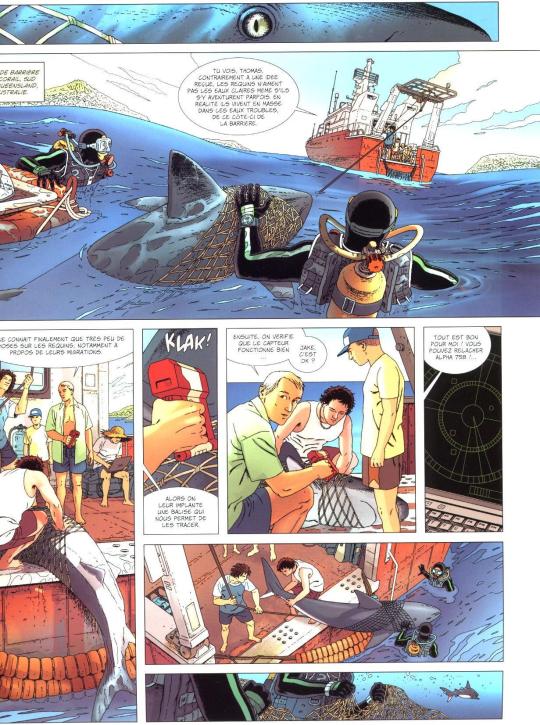
(Carthago vol. 3, “Le Monstre de Djibouti”, by Christophe Bec and Milan Jovanovic, 2013)
When I first got interested in ocean creatures as a little girl in the late 90s, we had several oversized white-covered books about Jacques Cousteau's ocean expeditions around the house that my parents let me page through, even though the text was way too small for me to read. A little later on, I read the Cousteau Society's young readers' magazine Dolphin Log/Cousteau Kids every month at the library, especially the selections from Dominique Serafini's comic book adaptations of the Calypso crew's adventures.
As an adult who's still interested in marine science, I've read several of Cousteau's books, and seen some of his documentaries. In 2019, I even got to hear his grandson Fabien speak at an event at the American Museum of Natural History.
Across film, TV, literature, comics, and even music, the Cousteau family’s underwater adventures are pretty well-documented. But one persistent bit of sea-folklore I've come across in various forms and places is an urban legend that at least one adventure wasn't. Somewhere in the world, these stories say, Captain Cousteau saw (or heard) something underwater that was so shocking that he kept it a secret from the world. (Except, presumably, from whoever is repeating the story.)
Could there be any truth behind this fantastic story? What was this "secret discovery"? And where and when did all of this happen? Like most urban legends, there are a lot of conflicting accounts and not a lot of proof.
I'd love to see a site like Skeptoid do a deep dive (heheh) into this story someday, but since they haven't yet, my research is below the cut.
A Secret Discovery?
It's alleged that after a submarine expedition, undersea explorer Jacques Cousteau said, "The world isn't ready for what's down there." (How Stuff Works)
As a reader and a writer, I have to say, this is an excellent pitch for a story. A world-famous explorer who witnessed all kinds of undersea wonders and environmental tragedies choosing to keep a remarkable discovery a secret for some unknown reason? Wouldn't you read that book? I'd read that book!
In fact, I did read that book! The French comic Carthago, first published in 2007 and translated into English in 2014, features a character based on Cousteau named Major Bertrand, a famous ocean explorer who made a discovery so shocking that he not only kept it a secret, but retired and lived the rest of his life onshore afterwards. The actual scene shown in flashback is a beat-by-beat retelling of the "Red Sea Monster" version of the story we'll discuss below. According to an interview with the comic's writer Christophe Bec, that scene (and the comic itself) were inspired by an article in the French paranormal magazine Le Monde de l'un découverte (The World of the Unknown) published in February-March 2001. That article is in French here.
Here are the broad outlines of the story as I've seen it in various places online:
Cousteau surfaces, shaken from a dive, OR
The Calypso crew recover either a shark cage that has been destroyed OR
An underwater camera or hydrophone that has recorded something
Cousteau says some variation on "The world is not ready for what I have seen"
Cousteau orders any film or audio recordings of the incident (taken by either divers, underwater equipment, or film crew aboard the ship) to be either destroyed or suppressed and hidden away in a safe
(Some accounts have people saying they actually saw the incident happen on TV, which is unlikely as I don't think any of Cousteau's documentaries were live broadcasts.)
Cousteau is so shaken by what he saw that he never returns to the site of the incident
The Red Sea Monster
The most famous and detailed version of the story, and the one Carthago adapts, sets the action in the Gulf of Tadjoura off the coast of Djibouti, near where the Red Sea meets the Indian Ocean. Investigating legends of a sea monster in a cove called the Ghoubbet al-Kharab, or Gulf of the Demons, Cousteau's team lowered a camel carcass within a shark cage. When the cage was raised, it had been badly damaged, perhaps even destroyed.

[The Ghoubbet al-Kharab is the little inland bit at left almost cut off from the sea x]
The article in Le Monde de l'un découverte says this incident happened sometime before 26 June 1995, when the secret was revealed by a writer(?) named Stéphane Swirog, and that it had also been discussed on French TV in 1987. (I cannot find any information about a “Stéphane Swirog” online except in reprints of this story, although there is apparently an MMA fighter with that name. Is this one of those hoax articles with backwards names where “Goriws” sound like something hilarious in French that’s lost on me?)
This is a plausible part of the world to set this story, because Cousteau very famously did explore the Red Sea several times! A lot of his film The Silent World was filmed there, and his Conshelf underwater habitat was on the floor of the Red Sea off Sudan. In 2004, Cousteau's son Jean-Michel and grandchildren Fabien and Céline returned to these sites fifty years later for a new documentary you can watch here.
And we know Jacques Cousteau actually DID explore the coast of Djibouti in 1967-68! In his book Life and Death in a Coral Sea (1971), he says that when docked there, his crew, err, heard a strange story...
...we decided to visit the Goubet, a famous gulf of the Red Sea. Before leaving Djibouti that morning, one of our crew had by chance asked a local Arab diver about the Goubet. "Ah, sir," the man had replied, "it is a most extraordinary place. It is bottomless, and it is inhabited by monsters so large that they can drag down lines attached to 200-liter cans. Moreover, in 1963, Commandant Cousteau went there with Fredéric Dumas and his best divers, and they were so terrified by what they saw that they ran away."
Naturally, we were eager to see the place in which, according to local gossip, we had earned so ignominious a reputation. I must report, however, that the Goubet was a disappointment. It is an inland sea or gulf that connects with the Red Sea by a narrow pass in which there is a very strong current, running up to seven knots. The surrounding area is very beautiful, and very wild, being dominated by volcanic mountains bare of foliage and marked in shades of red, yellow, and black.
Once in the Goubet itself, we lowered the diving saucer to a depth of over six hundred feet without catching sight of even a small monster. The divers then suited up and went down also, but they saw nothing more remarkable than some very large sea urchins. There seemed to be very few fish of any kind. It is my guess that the "Goubet monster" of Arab legend was originally a manta ray, seen by some shepherd from a hill top. Manta rays are plentiful in this area, and it must happen occasionally that they wander into the Goubet and – because the inlet is so narrow and because mantas are not the most intelligent of beasts – have trouble finding their way out again. (Page 42)
(This is one of those "white-covered books" I still own a copy of!)
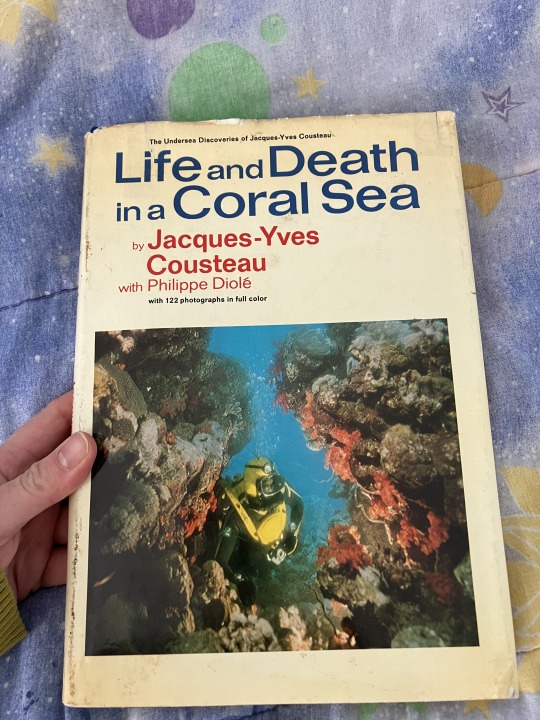

That's right, this story is so old it was told TO Cousteau in the late 1960s! It's the only version of the story he seems to have actually heard and commented on, and it was to deny the monster story.
It strikes me that two of the fearsome feats attributed to the Red Sea Monster— pulling air-filled cans/barrels underwater and destroying a shark cage— are things the shark in Jaws also does. While Peter Benchley’s novel came out in 1974, several years later, he did research sharks when writing it, so I wonder if “pulling barrels underwater” was just a bit of shark lore that was going around in the late 60s.
(At least the way it’s shown in the 1975 movie, the MythBusters showed a great white shark is strong enough to briefly pull barrel floats underwater but not to hold them there.)
The more embellished 2001 article post-dates Jaws and may be inspired by the cage-destruction scene in the film.
The Depths of Lake Tahoe
Apparently, years ago, Cousteau went scuba diving in Lake Tahoe. He emerged from the water shaken, but not with cold. He said, “The world is not ready for what I have seen.” (Jennifer Skene, “Rumors and Truth in Lake Tahoe”)
Another common account of the “secret discovery” story says that it didn’t happen at sea at all, but rather in the depths of landlocked Lake Tahoe, on the California-Nevada border. This is the version of the story most commonly associated with the “the world isn’t ready” quote. The Lake Tahoe version usually keeps things vague, speculating that perhaps Cousteau saw local legendary lake monster Tahoe Tessie OR a layer of hundreds of perfectly-preserved bodies of Chinese railroad workers or mafia victims floating eerily in mid-waters, OR some other mysterious thing too horrific to describe.
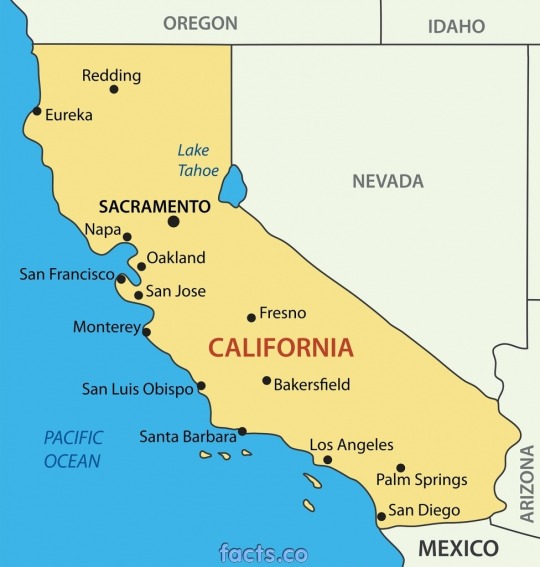
[Unspeakable horrors such as dinky maps found on Bing]
Both Tessie and the well-preserved bodies are urban legends seen discussed elsewhere without the Cousteau connection. Other legends speculate that the lake hides sharks, mermaids, an underground tunnel to Pyramid Lake, a crashed WWII bomber, and a fortune in gold bullion. Just your ISO standard set of underwater legends, really.
However, unlike the Red Sea, there is no evidence that Jacques Cousteau ever visited Lake Tahoe, let alone dove there!
According to other explorers who have explored the lake’s depths, the cold, clear waters do provide eerie visibility to the shipwrecks and sunken trees found there. While people have died in and around the lake and bodies are sometimes found, the more sensational claims of uncanny preservation and bodies eerily floating in mid-water, never rising or sinking, do not fit with Lake Tahoe’s known physical conditions.
The Screams of Hell
Indeed, the French diver Jacques Cousteau was swimming over Cuba some years ago, and he heard screaming noises at the bottom of the ocean. ... And Jacques Cousteau was so shaken up by what he had heard in the seas off Cuba, he never swam there again. ... He heard what he believed to be screaming, shouting, people being tortured, just as the Bible teaches. ("Ex-Catholics for Christ")
Yet another version of the story says that Cousteau heard the sounds of agonized screaming underwater, either while diving himself or recorded on a hydrophone, and possibly considered them the screams of souls in hell. These versions of the story tend to be vaguer, not always naming a time or place when this happened. (That version put it in Cuba, another in Greece, others vaguely “somewhere in the Bermuda Triangle”.)
That's probably because this version is just an adaptation of another, more well-known urban legend about Soviet geologists digging into hell and recording screams that has been repeated in various places since the 1980s. (You can see some of the problems with that story at the site linked.)
(Cousteau did explore Cuba’s waters in the mid-1980s as seen in the documentary, Cuba: Waters of Destiny. You won’t hear any screams from Hell in that documentary, but there is a guest appearance from Fidel Castro!)
Another religion-related urban legend about Jacques Cousteau is that he converted to Islam after discovering the Quran was correct about the mixing of the waters of the Red Sea and Indian Ocean. This isn't true, either. In some places I'd seen this repeated in the same context as an equally-untrue claim that Neil Armstrong converted to Islam after hearing the call to prayer on the moon, and misremembered this as a claim Cousteau had heard the call to prayer underwater for a less-disturbing twist on the idea that the secret discovery was something heard underwater rather than seen, but as far as I can tell, that isn't the case.
Bells in Random Order
Do you know Jacques Cousteau?
Well, they said on the radio
That he hears bells in random order
Deep beneath the perfect water
("Perfect Water")
The Blue Öyster Cult song "Perfect Water" has the lyrics above, which may be a reference to the "secret discovery" legend and specifically the above idea that it was a mysterious sound heard underwater. The band is known for having many references to legends, conspiracy theories, and the supernatural in other songs. "Perfect Water" was on the album Club Ninja, released in December 1985, post-dating Life and Death in a Coral Sea but predating the most famous accounts of the “Well to Hell” story. I can't find any other sources talking about Cousteau and mysterious bells.
This website instead thinks the lyrics are referring to Cousteau's actual descriptions of walruses as making sounds similar to bells in his writings and films. You can hear a walrus making a bell sound here.
Ask Me Anything
During an AMA session on Reddit in 2018, Fabien Cousteau (FCNomad) was asked about three different versions of this story (Djibouti, Lake Tahoe, and Fort Peck Reservoir in Montana.) He seemed most familiar with the Lake Tahoe version.
sotpsean: Hello, Mr Cousteau! It's an honour. When I was a child, family lived in Djibouti, Africa,(my father was a French Foreign Legionnaire). There was a local legend about a "sea monster" living in Lac Goubet. I've heard that your Grandfather might have investigated Lac Goubet in search of this "monster". Locals have thought it to be a prehistoric shark cut off from the sea. I've always wondered if someone might be able to shed light on this subject. Have you heard of this? Thanks for doing this AMA!
FCNomad: Great to chat with you. French foreign legion? Serious stuff. There are legends of "sea monsters" in every body of water out there. Until we explore them we will not know for sure ;-) Lets go see!
[x]
-
HulkVomit: Why did your grandfather never want to dive in Ft Peck Reservoir again? Would you ever come dive in it?
Account-002: I am also REALLY curious about this. My Dad thought it was because if the siltyness of the water, combined with a possible encounter with multiple giant catfish/paddlefish that put him off.
FCNomad: That does seem plausible and potentially sound due to the potential risks. He was focussed on filmmaking and if you can't see anything its hard to tell a visual story…
[x]
-
TeddysGhost: Hi there, I live at Lake Tahoe and it is a common story around here that your grandfather went into the lake once and when he emerged he warned people that the world isn't ready to see what's down there? What do.you know about that story? Is there even a shred of legitimacy and if so what did he see?
FCNomad: Ive heard this rumor as well. We were supposed to investigate on a new TV series but we never got the chance…
[x]
Conclusions
...yeah, all versions of this story sound pretty fake to me. Sorry.
As Fabien says, almost every body of water has sea and lake monster legends attached to it, because the world’s waters really are mysterious, unpredictable, and dangerous. But over time, your local legendary water monster can become familiar, almost a sort of community mascot.
When reading the archives of The Liberator, a famous anti-slavery newspaper published in Boston in the mid-1800s, I found several articles where the writers referred to the New England sea serpent in these kinds of familiar terms, since to Bostonians it was a “local” monster. They even called it “our American sea serpent”— the children and grandchildren of the Minutemen, still defining their identity as Americans, could boast that England didn’t have such a cool monster.
In modern times, of course, a local monster legend can also be a major tourist attraction. Most of the sites I found repeating the Djibouti and Lake Tahoe versions of the story were… travel sites for Djibouti and Lake Tahoe (especially diving travel sites).
To present your local monster story as “verified” by a famous underwater explorer like Jacques Cousteau makes it sound authentic. It certainly spices things up for people planning their vacations, especially divers. And to say that your local monster scared away a globetrotting adventurer like Cousteau who had faced so many other perils all over the world definitely adds to the “local pride” angle. In Djibouti, a French colony that was having a vote in 1967 about whether to become independent, a story about a local monster scaring away a famous Frenchman may have had an appealing nationalist undertone.
The writer for Le Monde de l'un découverte, however, probably just wanted to tell a rip-roaring sea story. The presumably-French writer, writing for a French magazine, would have been writing for an audience who had grown up following Cousteau’s adventures. Perhaps they combed his writings in search of any mention of sea monsters that could fit in their paranormal magazine, found the passage about Djibouti in Life and Death in a Coral Sea, and created a more sensational version that conveniently left out Cousteau’s own debunking. For an audience who had grown up with Cousteau, what could be more exciting than hearing about one more adventure of their late hero, totally new and unseen, and a discovery so shocking it was being kept secret?
And, like I said, it does make for a great story! No wonder it inspired Christophe Bec to write his own version! And with the decades-long tradition of fictional stories parodying and homaging Jacques Cousteau, I can’t blame you if this piece has inspired you to write your own version of the “secret discovery” story— just please, make it clear that your fiction is fiction.
22 notes
·
View notes
Text
Horror novel recommendations
@allthestoriescantbelies asked for horror novel recommendations, so I thought I’d throw one together to post on the blog! Largely focused on non-gothic stuff since I’ve already made a gothic lit list over here.
As a general warning, all horror books listed here will have potentially triggering material. If you want more specific trigger warnings, you can ask me or see if people have listed them on goodreads or storygraph.
My Best Friend’s Exorcism by Grady Hendrix: I know you’ve read this, but I’m putting it on the list because it is one of the scariest books I’ve ever read, about a teenage girl in trouble and the only other girl willing to help her. I’m told the movie makes it much more straightforwardly comic rather than horror-with-jokes, which disappoints me. I’m a big fan of Hendrix in general, though I know you (and plenty of others!) find him hit-or-miss.
Red Dragon by Thomas Harris: Another one I believe you’ve read, but for reference, it’s the best serial killer thriller I’ve ever read. Francis Dolarhyde is a much more interesting character than Hannibal Lecter, I will die on this hill.
We Will All Go Down Together by Gemma Files: Centuries ago, the Five Family Coven made a deal with the Fairy Queen, and their descendants have been doomed ever since. I could have just as easily recommended Files’ book Experimental Film- if you like one, read the other as well.
The Drowning Girl by Caitlin R. Kiernan: A schizophrenic woman has two different memories of her ex-girlfriend and the horror that followed her- was she a werewolf, a mermaid, or were both memories wrong? This is Kiernan at her most heartfelt and most accessible; if you like this and want to try her grosser stuff, read The Very Best of Caitlin R. Kiernan.
House of Leaves by Mark Z. Danielewski: A haunted house in a haunted film in a haunted memoir, written in a work of visual art. I won’t blame anyone who bounces off this, but give it a try!
Carrie by Stephen King: If you’re only going to read one Stephen King, make it either Carrie or Misery. I don’t feel like any film adaptations have captured all the aspects of this tragedy about a girl who deserved a better life and the town who didn’t save her while there was still a chance, including the epistolary format.
Rolling in the Deep by Mira Grant: This novella was followed up by Into the Drowning Deep, but I found Rolling in the Deep much scarier. It’s brisk and high-tension to watch a semi-fake documentary team put together, piece by piece, just what the monsters are that pursue them.
Dark Harvest by Norman Partridge: The Great Pumpkin, but scary! Seriously, though, if you are willing to accept the concept of a boy with a pumpkin head and a knife and a yearly child sacrifice, this is short and a lot of fun.
The Only Good Indians by Stephen Graham Jones: Just an elk killed when some kids were blowing off steam. Just an elk damning the rest of their lives. (Jones’s My Heart is a Chainsaw was too sad for me to recommend as a favorite, but I am curious about the sequel.)
The Wolfen by Whitley Striber: I wanted to include a good werewolf novel on this list, and The Wolfen wins by far for interesting creature design. (The runner up was The Last Werewolf by Glen Duncan.)
The Auctioneer by Joan Samson: A very atypical entry on this list, closer to Twin Peaks than your average thriller. A rural town is turned into a capitalist police state when a slick salesman comes to see what they’ll allow him to do. It turns out, it’s a lot.
The Drive-In by Joe R. Lansdale: The only “splatterpunk” I’ve ever loved, this is an absurdist nightmare about a southern drive-in crowd who get stuck in a world with only the movie screens and each other, turning into literal and figurative monsters. Usually published with the sequel, since both are short, though I didn’t like the latter as much. If you like it, read one of Lansdale’s short story collections.
As always, reblog with suggestions of your own!
130 notes
·
View notes
Text




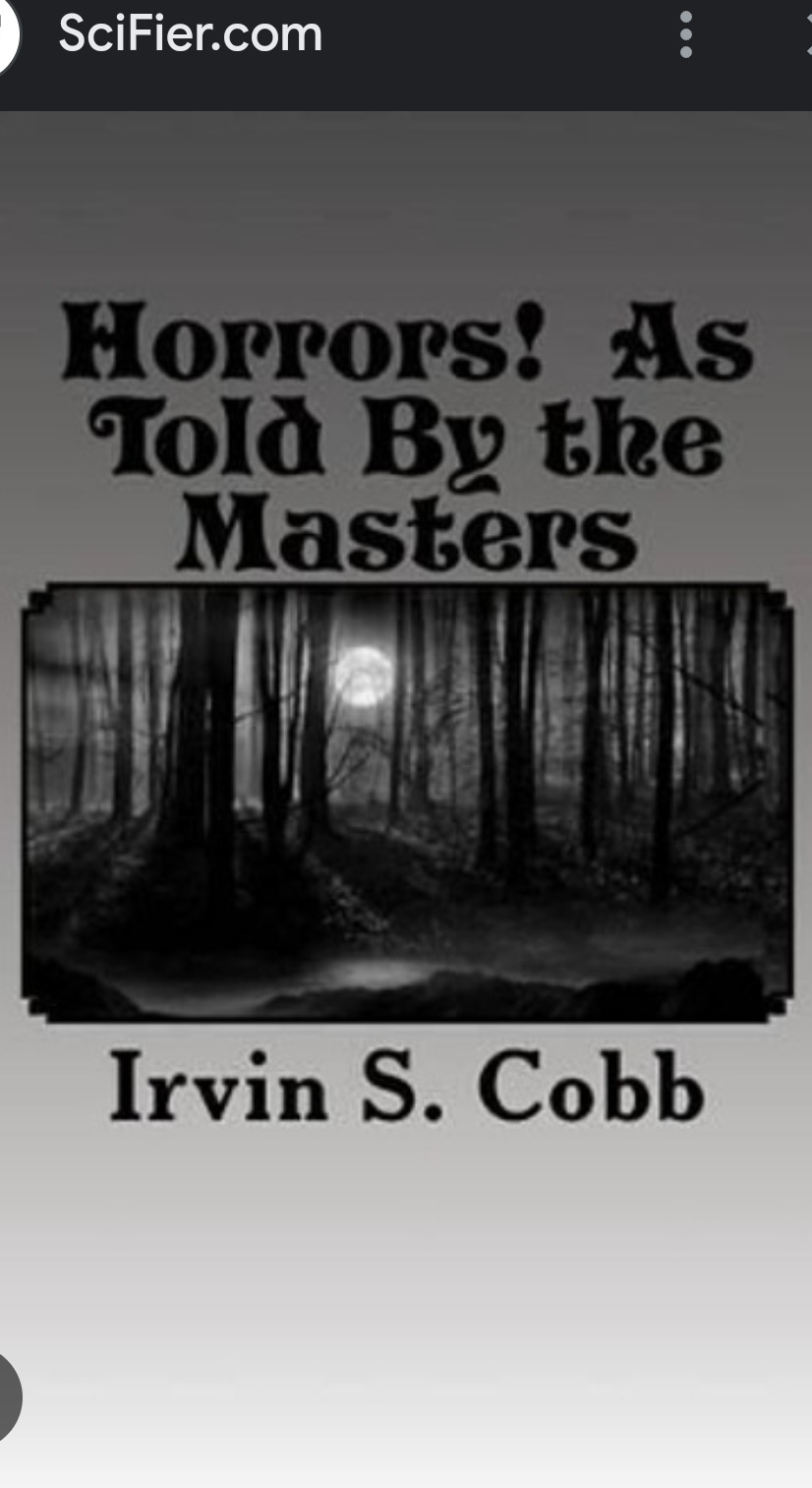
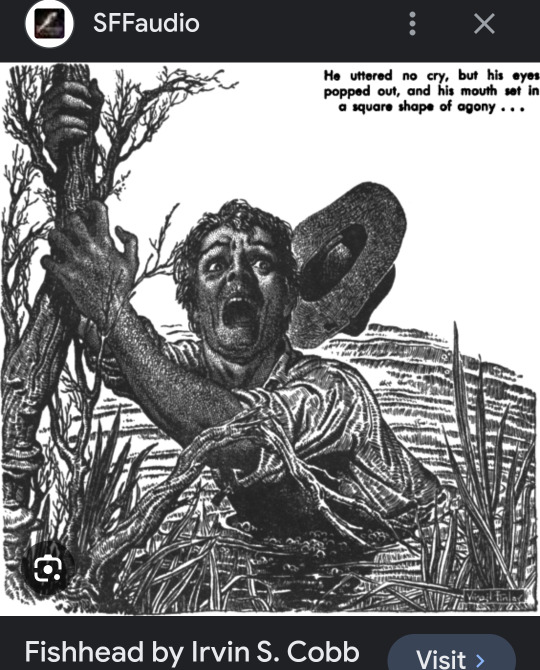
Pics: Inspiring HPL.
1. Irvin S. Cobb - American writer, editor, humorist & columnist hailing from Paducah, Kentucky¹.
He was the highest paid staff reporter on the NY World newspaper².
Irvin would write 60+ books & around 300 short stories.
Some of which were adapted into silent movies. And, 2 of his later tales were actually filmed, by the famed John Ford³, during the 1930s!
2. Cobb's "dark side" (horror works) of the otherwise lighthearted comedian & the story in question.
3 & 4. Comedic frontpieces(?) for books by Cobb. The 2nd even boasts an Abraham Lincoln quote!
5. Cover to Cobb's collection of other authors's short horror tales.
6. Inside art from Fishhead's ending...
1913 Addendum -
Intro: Irvin Cobb's infamous short story "Fishhead" is set in the back- wood bayous of the vast Reelfoot Lake⁴.
Plot: The tale concerns the murder of a local outcast freak by "poor whites."
With its surprise Jaws⁵-like ending, this gruesome work reminds readers of an issue of EC comics⁶!
Criticism: Lovecraft lauded Cobb for, "... Carrying on our (own) spectral tradition is the gifted... humorist, I.S. Cobb, whose works... contain some finely (made) weird (tales)."
Of the plot, Howard stated that, "Fish- head" (is) an early achievement, ... banefully effective in its portrayal of (an) unnatural... hybrid idiot & the strange fish of an isolated lake."
Lovecraft further opined, "It is (my firm) belief... that... few short stories of equal merit have been published anywhere (else)..."
Legacy: Cobb's "Fishhead" is seen as a major influence on Lovecraft's own "Shadow Over Innsmouth."
Robert M. Price⁷ noted that, "What (Howard) found revolting was the idea of interracial marriage (&) of different ethnicities mating, (thus) 'polluting' the (white? human?) gene pool."
Fishhead is supposedly "the son of a Negro father & a halfbreed Indian mother." It's never mentioned what her other half was from...
This is the same premise behind HPL's "The Shadow Over Innsmouth."
Except that Lovecraft calls them Deep Ones & has a whole city that's been 'turned'...
More when we get to this story...
Notes:
1. Paducah, as 1 out of 9 U.S. Creative Cities, is a haven for thinkers, artists & creators!
Architectural Digest recognizes this city's historic district as 1 of the most beautiful main streets in America.
There are 20 downtown blocks listed in the National Register of Historic Places!
Weird Shit: Paducah's nickname is "The Atomic City."
This was because it was once the U.S.'s only uranium plant, making atomic bombs for our Defense Department...
2. The NY World newspaper began (in 1860) as a leading voice for the US Democratic Party.
But, once under Joseph Pulitzer, it became a pioneer in "yellow journalism."
Catching readers's attention with sensational (sex, sport & scandal) news stories.
This raised their circulation past the 1 million mark!!
Best known for being among the 1st to publish daily comic strips.
They actually created "Hogan's Alley", "Everyday Movies", "Little Mary Mix- up" & "Joe Jinks!"
Merged with The NY Telegram in 1931.
Revived - online - in 2011 by Columbia U. But, hasn't had any new content since 2016...
3. John Ford was an American movie director who won Oscars for "The Informer", "The Grapes of Wrath", "How Green Was My Valley" & "The Quiet Man."
The best of his many Westerns are "The Searchers", "Stagecoach" & "My Darling Clementine."
4. Reelfoot Lake is a real lake best known for its shallowness - about 5½ feet on average.
It's located in western Tennessee &, strangely enough, no swimming is allowed there...
The lake is named after an 1800's Chickasaw warrior with a deformed leg...
Reelfoot Bayou, with its cypress trees, flows out of the lake to join the Obion River - which runs straight to the Mississippi.
5. "Jaws" is, of course, director Steven Spielberg's 1st international master- piece.
And it doesn't need any hype, from me, for you to see it again!
97% on Rotten Tomatoes!!
Enough said...
Make it so!
6. E.C. Comics was an American publisher specializing in horror, crime, dark fantasy & sci-fi comicbooks.
William Gaines printed mature tales of war, adventure, satire, etc...
Noted for its stories high quality, shock endings & progressive social awareness.
Among the themes that EC creators touched upon are: racial equality, anti- war sentiments, nuclear disarmament & even early environmentalism!
Sadly, official censorship forced EC to focus on its "Mad" magazine - which became it's greatest success!!
EC has just been revived, by Oni Press, on this past February of 2024!!
Good times guaranteed...
7. R.M. Price is an American biblical scholar, author & an authority on H.P. Lovecraft.
His works include: "Deconstructing Jesus", "The Reason Driven Life", "The New Lovecraftian Circle", "World War Cthulhu", "The Disciples of Cthulhu", "Arkham Detective Agency", "The Da Vinci Fraud", "The Apartheid State in Crisis" & more great stuff!!
Price was the editor of the greatly lamented Crypt of Cthulhu, Midnight Shambler & Eldritch Tales fanzines.
He even edited a whole series of Mythos anthologies for Chaosium.
Today, Price is editor of The Journal of Higher Criticism!
Busy little tentacle, ain't he...
12 notes
·
View notes
Text

Tiger Girl was an Indian princess version of Sheena who appeared continuously for nearly a decade in Fight Comics, published by the heroine-friendly Fiction House, between 1944 and 1954, the year of the publishing house’s demise. Apart from the setting of a never-never “lost kingdom” in a non-specific part of Africa, there was little to distinguish Tiger Girl from her East African inspiration, other than the lethal-looking bullwhip she wielded in order to subdue her enemies and her two “pet” tigers , the aptly named Scimitar and Spear, whom she deployed to protect her “domain” from evil intruders and exploiters.
Tiger Girl’s back story was interesting in that she was the daughter of an Indian aristocrat named Rajah Vishnu and an unnamed Irish mother. This actually made her the only mixed race jungle woman of the Golden Age but inevitably, and in true Sheena homage style, she was inexplicably depicted with flowing golden tresses (although interestingly, in her earlier adventures she is shown as a redhead). Her father brought her to Africa, somehow founded a realm there, which his daughter took to patrolling in adulthood in true jungle girl fashion, complete with tiger skin bikini. Tiger Girl, like Sheena, tended to the more “savage’ aspect of the jungle heroine’s nature, frequently not taking her loathsome enemies alive to face justice, but allowing the brutal laws of the jungle to run their course. Derivative Tiger Girl may have been, but she was a popular storyline, indicated by the title’s longevity and by the fact she was Fight Comic’s cover character for much of her run.
In the page featured, a crazed scientist named Remington, attempting to take over Tiger Girl’s kingdom with an army of intelligent apes, is defeated by a combination of the jungle girl’s whip, her two tigers and a friendly local tribe. We are assured the vanquished Remington “shall pay!” but what that means is left to our imagination.
Tiger Girl was the creation of artist Robert Hayward Webb, who also worked on Sheena. The writers of her stories are unknown. The page featured is from the Tiger Girl adventure in Fight Comics #80 (May 1952).
Sources: Bleeding Cool website and comicbookplus
#women in comics#tiger girl#golden age comic book heroines#golden age of comics#fiction house#fight comics#jungle heroines#jungle adventure
7 notes
·
View notes
Text
New Games on Itch.io - January!
This is a post from the Indie RPG Newsletter!
Before we get to the games themselves, let me talk about itch.io for a minute. The website was designed for selling videogames but the indie RPG scene adopted it like a hermit-crab chancing upon a toy truck on the beach. This has led to some strange problems. The RPG category is called “physical games”, for example. More generally, it’s a bit confusing to navigate for the average customer.
So why has this eccentric site become the host of this glorious explosion of indie game design and creativity? I can’t say for sure. Maybe its because it was designed as a protest against Steam and turns out that DriveThru has a lot of the same problems. Maybe it’s because the site makes it incredibly easy to publish games. Maybe it’s just a coincidence - a quirk of luck, just network effects compounding into something greater.
But regardless, there’s cool stuff everyday on that site - a LOT of cool stuff. So here’s my attempt at curating the games that came out in January. I found these games either by browsing the site or through people notifying me with this form. Now the important disclaimer is that I haven’t read or played most of these games. This list is me excitedly pointing out things in the shop window, take it in that spirit. My taste is idiosyncratic, so please publish your own lists! And maybe send me a link, I’d love to see them!
Itch.io January Roundup
blasé monotony by Apri describes itself as “a duet game about having conversations while bored at work” but that description hides this dramatic second act. An astronaut and someone in the control room start talking and then things start going wrong… (Free/PWYW)
Lost & Shelved by Donogh McCarthy is a solo game about a librarian finding strange and ephemeral things in the pages of returned books. I’m a sucker for anything about librarians and Donogh McCarthy is a real indie darling as far as I’m concerned.
Undisturbed by GGoldmen is a solo journalling game about dissecting human cadavers. Seems like a very thoughtful game on a grotesque subject! (Free/PWYW)
A Sage’s Salary by krushna is a solo game about a student and their sage. From an Indian designer, sages aren’t neutral figures - they’re a caste. Which makes this more interesting! I started playing but haven’t finished my playthrough of this.
Apocalypse Roadtrip by Mynar Lenahan is a forged in the dark game where you dodge “roaming Kaiju, military bombings, otherworldly cryptids, UFO fleets, and other survivors (friendly and not)”. That sounds like a good time!
5 Act Play by K-Ramstack is a solo roleplaying game where you create a 5 Act Shakespearean play based around prompts.
Dice of War by Torsten Kaltenecker is a comic game about “battles, historians and intellectual disagreements”. Um, yes! Also bonus points for “sulking in a dignified way is recommended”. (Free/PWYW)
The Belles of the Ball is an adventure by boyproblems for Heroes of Myth and Mettle. “A masquerade ball, an ancient mysterious city, a wealthy man playing at vigilante, and the Zool Chamber of Commerce. It's a party you won't want to miss.” (Free/PWYW)
Conflictus Ad Astra by Gabriel Ciprés is an expansion for the very cool (and free) game Space Knights, which is a kind of PbtA Warhammer where each player controls their own legion. (Free/PWYW)
Cold Decisions: The Cult of Namenlos by Mundos Infinitos is a “cult simulator” and honestly, enough said.
Honourable mentions: A complete, final version of Apocalypse Frame, the fast and tactical mecha game, came out this month. Also, D12 and Delve is a dungeon-delving RPG in 12 words by WH Arthur where your character is a business card.
72 notes
·
View notes
Text
Lesser known Pulp Heroes.
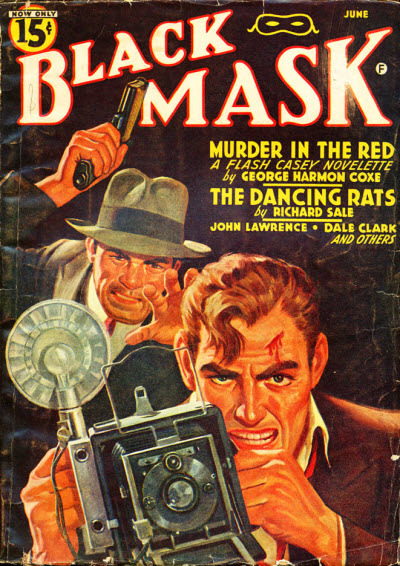
Flash Casey (sometimes Flash Gun Casey) by George Harmon Coxe, a tough-guy newspaper photographer, the first “hard-boiled” mystery character, along with appearing in Black Mask, the character was also in B-movies, radio, and a short-lived Timely Comic book.
The Domino Lady by Theodore Tinsley, she fought crime and/or evil while wearing a black mask and white gown.
The Crimson Clown by Johnston McCulley, the creator of Zorro, C.C., was a modern (the 1930s) crime fighter, who used skills learned in W.W. I,, a .45, and a syringe full of a knockout/truth serum (later a gas gun) To rob from the unjust rich and give to the poor.
The Moon Man by Frederick C. Davis, the one who went into battle against crime with a glass bowl over his head.
Captain Satan by William O'Sullivan was sort of a harsher version of The Shadow and Doc Savage; only all of his aids were criminals and not reformed ones, who feared Cap. S more than the law, and who regularly died during the stories as more were added.
Senorita Scorpion by Les Savage Jr. is a Western character who came from a gold-filled valley that had been sealed off from the world for more than 100 years, After an opening appeared she defended it from various Western baddies.
The Patent Leather Kid little known kinky crusader character of Erle Stanley Gardner.
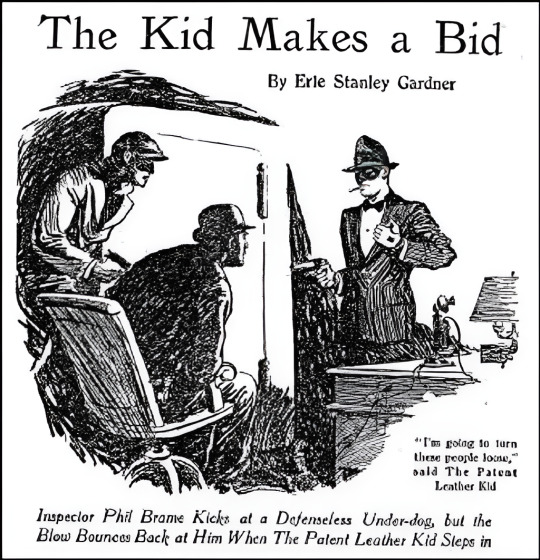
Masked Rider by Paul Chadwick, the M.R. was a pulp published by the company that would become Marvel Comics, an early high-concept character. He was a blend of The Lone Ranger and the Shadow, later, he was sold to Popular Publications, who redesigned him toning down the “shadow” bits, but keeping the mask and his Indian side-kick Blue Eagle.
Thubway Tham, Johnston McCulley again. Tham was a grumpy older pick-pocket with an exaggerated lisp, who, while ill-tempered and a crook, had a well-hidden heart of gold and ended up helping the innocent against big-time crooks most of the time.
23 notes
·
View notes
Text
Shri Ram Janmbhoomi Comic Book - Suruchi Prakashan
श्री राम जन्मभूमि कॉमिक्स - सुरुचि प्रकाशन (Shri Ram Janmbhoomi Comic Book - Suruchi Prakashan)
Suruchi Prakashan
#shreeram #RamJanmabhoomi #rammandir #ayodhya
#ComicsByte #comicbooks #newrelease
#comic books#indian comics publishers#comics byte#comics news#comics#new release#ram mandir#ramayan#shree ram#ramayana#Shri Ram Janmbhoomi#Comc Book
0 notes
Photo

Hergé (Belgian, May 22, 1907 - March 3, 1983)
Belgian author and artist, 1907-1983. Translated into over thirty languages, Hergé’s adventure stories about the brave and resourceful young reporter Tintin are popular with both children and adults throughout the world In twenty-four book-length comic strips, Tintin and his faithful fox terrier, Snowy, embark on a series of thrilling global adventures set in remarkably detailed, meticulously researched landscapes.
Hergé. whose real name is Georges Remi (he devised his pen name by inverting his initials to R.G.), published the first Tintin adventure in Le Petit Vingtième, the children’s supplement to Le Vingtieme Siecle, in 1929. Published in book form in 1930 as Tintin in the Land of the Soviets, this primitive work is the only one of the series that was not later translated into color, with the exception of Tintin and the Alpha-Art, a work unfinished when Herge died and left in sketch form at his request.
The second adventure, Tintin in the Congo (1931), reflects a contemporary European view of Africa based on ignorance and portrays the African people as gullible and naive. Neither Congo nor the fanatically anti-Communist Soviets has yet been published in the United States.
In Tintin in America (1932), Tintin takes on Chicago mobster Al Capone, and Hergé’s sociopolitical satire becomes more sophisticated as he depicts the National Guard driving the Blackfoot Indians away from their ancestral lands. But it is probably The Blue Lotus (1936) that marks Hergé’s refinement of detail and concern for accuracy.
After befriending a young Chinese student who urged him to avoid common stereotypes, Hergé began to delve further into research of the physical and cultural landscape. The story is a clear protest of Japanese expansionism on the Chinese mainland and of the treatment of the Chinese people by many Westerners. Hergé’s friend appears as young Chang in The Blue Lotus and later in Tintin in Tibet (i960), a story of true friendship Hergé claims as his favorite.
Ostensibly a journalist, Tintin is seen reporting to his editor only once in the series and follows his sense of adventure and justice rather than any particular assignment. In the course of his adventures he encounters a colorful cast of characters who become his cohorts: The bumbling, ineffectual detectives Thompson and Thomson, the rough old sea dog Captain Haddock with his legendary penchant for drinking whiskey and hurling passionate but innocent insults, and the absent-minded but ingenious Professor Cuthbert Calculus provide both help and hindrance throughout Tintin’s travels.
All of these characters find their way aboard the first manned rocket bound, for the moon in Destination Moon (1953) and Explorers on the Moon (1954), in which Tintin, Snowy Captain Haddock, and Thompson and Thomson set foot on the moon fifteen years before Neil Armstrong landed in Apollo 11.
Hergé constructed a detailed scale model of a German U2 rocket to create the drawings, and his extensive scientific research gives the books remarkable accuracy and foresight. While most of the Tintin stories are noticeably devoid of women, opera singer Bianca Castafiore takes center stage as a strong female character in The Castafiore Emerald (1963).
Charles de Gaulle once remarked, “My only international rival is Tintin.”
source: Children’s Books and their Creators by Anita Silvey.
Hergé’s Tintin books in chronological order:
Tintin in the Land of the Soviets – (Tintin au pays des Soviets) (1929–1930)
Tintin in the Congo – (Tintin au Congo) (1930–1931)
Tintin in America – (Tintin en Amérique) (1931–1932)
Cigars of the Pharaoh – (Les Cigares du Pharaon) (1932–1934)
The Blue Lotus – (Le Lotus bleu) (1934–1935)
The Broken Ear – (L’Oreille cassée) (1935–1937)
The Black Island – (L’Ile noire) (1937–1938)
King Ottokar’s Sceptre – (Le Sceptre d’Ottokar) (1938–1939)
The Crab with the Golden Claws – (Le Crabe aux pinces d’or) (1940–1941)
The Shooting Star – (L’Etoile mystérieuse) (1941–1942)
The Secret of the Unicorn – (Le Secret de la Licorne) (1942–1943)
Red Rackham’s Treasure – (Le Trésor de Rackam le Rouge) (1943)
The Seven Crystal Balls – (Les Sept boules de cristal) (1943–1946)
Prisoners of the Sun – (Le Temple du soleil) (1946–1948)
Land of Black Gold – (Tintin au pays de l’or noir) (1948–1950)
Destination Moon – (Objectif Lune) (1950–1953)
Explorers on the Moon – (On a marché sur la Lune) (1950–1953)
The Calculus Affair – (L’Affaire Tournesol) (1954–1956)
The Red Sea Sharks – (Coke en stock) (1956–1958)
Tintin in Tibet – (Tintin au Tibet) (1958–1959)
The Castafiore Emerald – (Les Bijoux de la Castafiore) (1961–1962)
Flight 714 to Sydney – (Vol 714 pour Sydney) (1966–1967)
Tintin and the Picaros – (Tintin et les Picaros) (1975–1976)
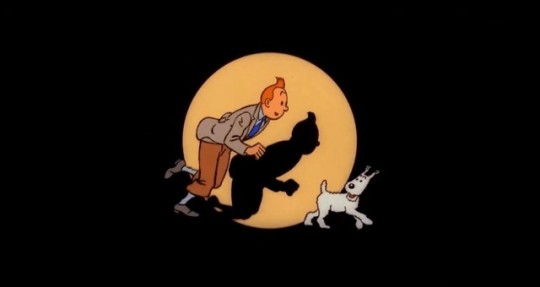
41 notes
·
View notes
Text
Bootlegging Wonder Woman
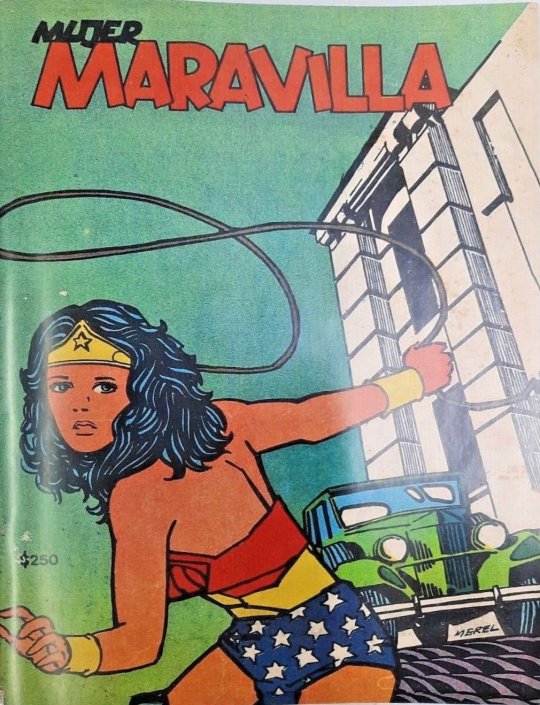
We're all very familiar with the idea that our favourite movies and tv shows are sold around the world and adapted into local cultures, but we occasionally forget that other media, such as comic books, sometimes also have a life outside of their domestic markets.
Marvel occasionally founded subsidiaries to control its overseas publishing, such as the famed Marvel UK, but DC was happy just to license its artwork to foreign publishers where they could be edited and adapted to fit the local market. Because of this DC characters like Superman and Batman could find themselves frequently switching from comic-to-comic, publisher-to-publisher, every few years, even sometimes sharing space with non-DC superheroes in anthology titles.
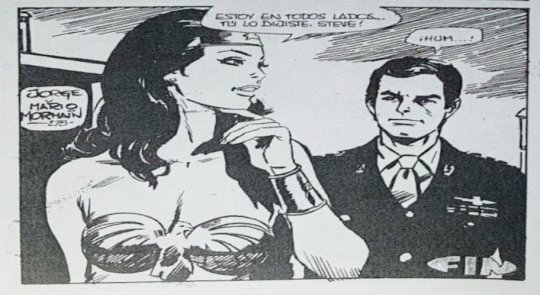
Of course, not every foreign publisher necessarily went through the legitimate licensing route. If you scour the pages of various Indian comics, for example, you'll find sly cameos by the likes of Superman, Spider-Man, and various other American heroes lurking within their stories. But some foreign publishers went a step further. Not content with merely restricting themselves to just cameos, they created their own entire line of unauthorised comics focused on American characters.
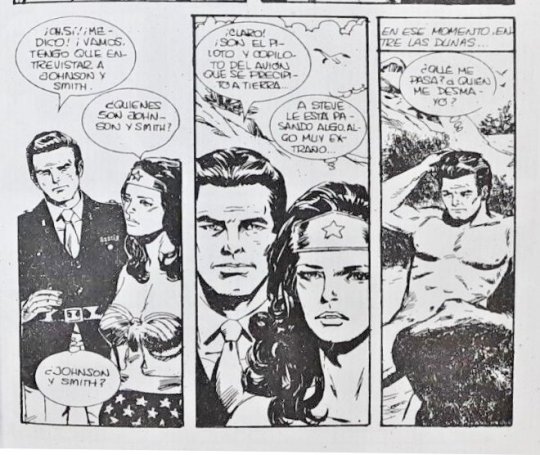
Which brings us to Mujer Maravilla -- a short run comic from Argentina that based itself heavily on the Lynda Carter (@reallyndacarter) Wonder Woman tv show.
Spanish translated versions of Wonder Woman had been legitimately published in Mexico under the title Marvila, La Mujer Maravilla for many years before the Lynda Carter show appeared on US screens, but the Argentinian version was (as far as anyone can tell) entirely bootlegged. The stories, the artwork, the whole comic from cover-to-cover was produced by local talent, without any input from DC Comics or Warner Bros., and without using any art from the US comic strips.

The stories followed the style of the tv show pretty closely, with some stories borrowing ideas from the ABC season World War II setting and some from the later CBS modern day setting. Each issue had 20 or 22 pages of Wonder Woman in black and white, presumably split between a couple of stories, with a 12 page cartoon strip entitled Mini Maravilla rounding off each issue. What scant online references there are for this comic suggest that Jorge C. Morhain scripted each story, with Mario Morhain and Gene Quinterno providing the artwork.
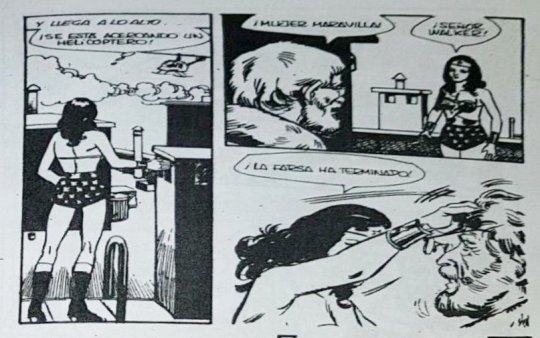
With an alleged run that lasted just eight issues, original copies of Mujer Maravilla are extremely rare and pricey. There's not a lot of material online about these comics, and even the Grand Comics Database doesn't seem to document them (unless, perhaps, they're hiding under a different title.) There's some suggestion on social media that the strips may have been reprinted in the 1990s as part of a book or collection of bootleg superhero comics (including the now famous Bat-Manga), but the details of these reprints -- if they ever existed -- remain stubbornly obscure. Certainly there are copies of specific issues described as "reprints" floating around on eBay, but the provenance of these comics is hard to trace.
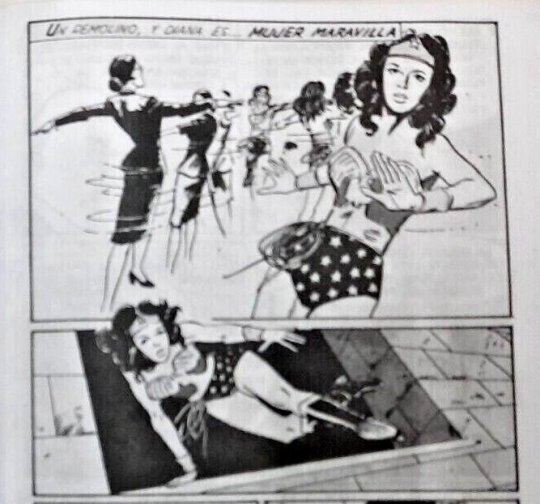
I'm indebted to @muttonchopsalley, who managed to track down some page scans so fans can at least get a taste of what they're missing.
12 notes
·
View notes
Text



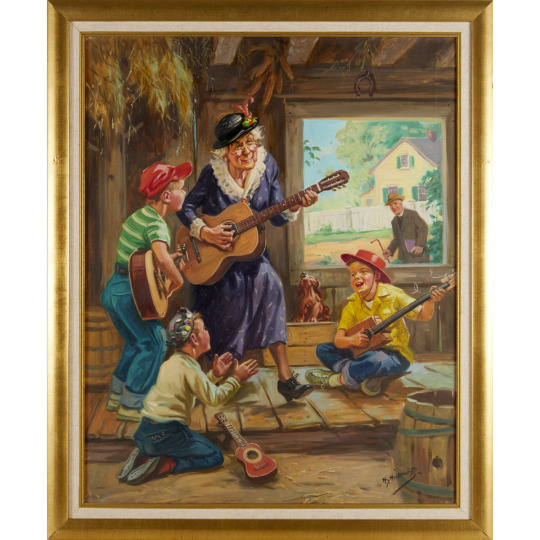

Henry "Hy" Hintermeister (American, 1897-1970)
“Grandma” series.
Oil on canvas
Henry Hintermeister (1897-1970) was a painter and illustrator who painted in the Golden Age of Illustration under the signature Hy Hintermeister. He painted as team with his father, John Henry Hintermeister, and together they created more than 1000 works. Henry may have begun began his professional career as early as 1914 (age 17), when a copyright for a Henry Hintermeister was registered. He is best known today for his "American themed paintings."
Henry’s earliest published works featured family, images of women and children, dogs, horses and recreation. He also painted fantastic scenes, with Indian maidens and scantily clad Romans and Egyptians. In later years he created ionic and semi-comical works, with subjects including the multiple dangers of crossing the street, children and grandparents, fishermen, policemen, boy scouts and hunters. Seen in Sports Afield, Outdoor Life and lots of Champagne Velvet beer advertisements.
Millebros
10 notes
·
View notes
Text
Happy Queer Media Monday!
Today: The Movement from DC Comics
Inclusive superhero group done right.
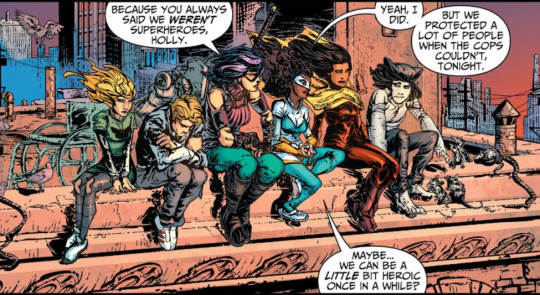
(The team sitting over their city at the end of the first story arc. From left to right: Vengeance Moth, Burden, Katharsis, Virtue, Tremor and Mouse.)
The Movement is a 12 issue comic book series published in 2013 and 2014 by DC Comics as part of The New 52. It is probably best known on Tumblr for featuring the heroine Tremor, who is canonically asexual, but it has so, so much more to offer.
The Movement is a group of disenfranchised teenagers in Coral City, led by Holly Ann Fields aka Virtue. The series can be kind of divided into three story arcs: Their fight against the corrupted police (issue 1-8), Batgirl visiting (issue 9-10), and Burden’s fight against his brother (issue 11-12).
Superheroes being used as a metaphor for oppressed groups is nothing new, but what makes The Movement special is that they really are an incredibly diverse group, featuring many different identities. We have:
Virtue / Holly Ann Fields, who is a Black lesbian,
Tremor / Roshanna Chatterji, an asexual Indian immigrant,
Mouse / Jayden Revell, who could be argued to have an intellectual disability, though nothing concrete is actually said,
Katharsis / Kulap Vilaysack, a Laotian immigrant,
Burden / Christopher, who is gay,
Vengeance Moth / Drew Fisher, a former addict and wheelchair user with muscular dystrophy
Here is an article from when the series launched, where the creator discusses the politics of it, and a lengthy one written at the end of its run about how it championed diversity in the superhero comic medium.
Here are the Wikipedia and DC fandom wiki articles about the series.
Queer Media Monday is an action I started to talk about some important and/or interesting parts of our queer heritage, that people, especially young people who are only just beginning to discover the wealth of stories out there, should be aware of. Please feel free to join in on the fun and make your own posts about things you personally find important!
#thought I could get away with this during#disabled pride month#not because it has a disabled queer character#but because it has a team that does both the queer and disabled members justice#SUCH. A. GOOD. TEAM#and it is like completely impossible to find anything about them on here#occasionally somebody mentions#Roshanna Chatterji#Tremor#but even then only that she is asexual#nothing else#and it's such a pity#because both she and her team have got very interesting personalities and stories#my favorite probably is#Drew Fisher#Vengeance Moth#IDK I just like her#quite possibly because she is disabled#which most superheroes are#but in her case her disability actually affects her powers negatively#instead of being their source#The Movement#DC comics#superheroes#comic books#the new 52#canon queer characters#canon disabled character#Queer Media Monday
8 notes
·
View notes
Text

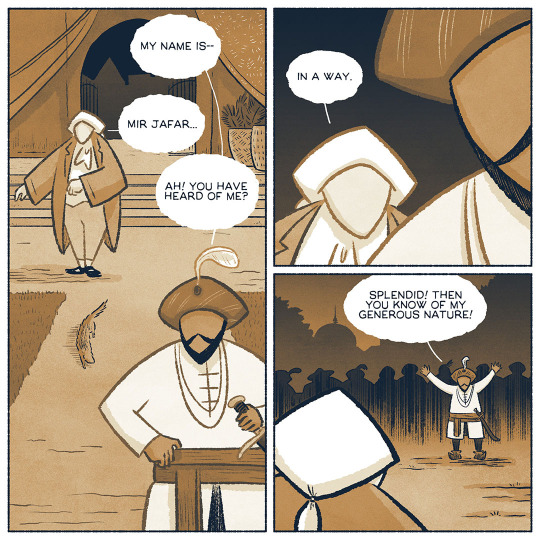

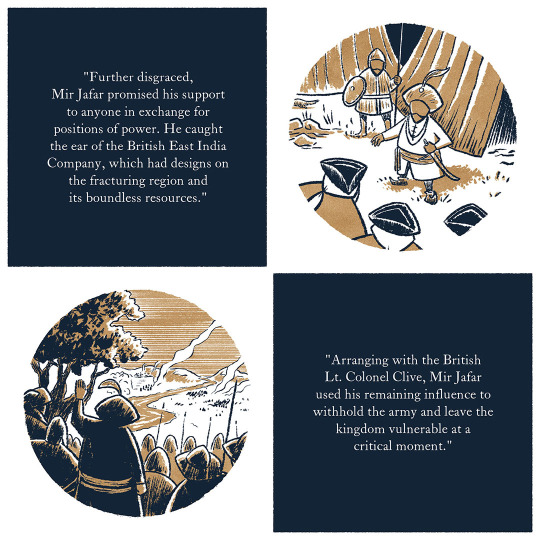


The Odyssey of Benedict Arnold - Mir Jafar
Another history interlude featured in Benedict Arnold’s journey, this time he runs into the infamous Mir Jafar!
I ended up reading far beyond his point in history to get an idea of British Rule in India and was really taken in by a lot of the stories, especially Yasmin Khan's book! Looking to read their other works when time allows. I did my best to summarize and some of the sources are noted below (although not all dealt with Mir Jafar).
These are spread out over the course of Chapter V. Arnold is invited to a celebration of sorts before it is rudely interrupted by a gang of monstrous unicorns!
https://ko-fi.com/mongooseandson (For Reading Ahead + Support!)
https://www.webtoons.com/en/challenge/the-odyssey-of-benedict-arnold/list?title_no=594697 (For General Comic Viewing + Subscribes!)
Notes:
Durant, Will. The Case for India. Simon & Schuster: New York, 1930.
Khan, Yasmin. India at War: The Subcontinent and the Second World War. Oxford University Press: New York, 2015.
Morton-Jack, George. Army of Empire: The Untold Story of the Indian Army in World War I. Basic Books: New York, 2018.
Tharoor, Shashi. Inglorious Empire: What the British did to India. Hurst & Co. Publishers: London, 2017.
#history#biography#artists on tumblr#comics#mir jafar#benedict arnold#the odyssey of benedict arnold#webtoon#ko-fi#Illustration#digital painting#india#yasmin khan#george morton-jack#shashi tharoor#will durant#british east india company
12 notes
·
View notes
Photo

1942 04 05 Ceylon, Hurricane IIB 30 Sqn Jimmy Whalen vs Val - Jaroslaw Wrobel
Born in Vancouver, British Columbia in April 1920, James H. ‘Jimmy’ Whalen took interest in aviation as a boy and graduated from secondary school in June 1938. He quickly joined the Commonwealth Air Training Programme, learning to fly in Ottawa, Ontario, receiving his wings in January 1941. In 1941 Jimmy flew Spitfires over England with 129 Squadron, taking aprt in fighter sweeps and downing 3 Bf-109s. Meanwhile, 30 Squadron suffered heavy blows in combat over Crete and were subsequently posted to Alexandria, Egypt on night defence duties. With the Japanese entering the war in December 1941, making huge and rapid strides against British Empire territories in southeast Asia, there was a sudden need for fighter strength to defend the eastern empire. Jimmy volunteered for a posting, and three weeks later (January 3rd, 1942), he was flying across Africa co-piloting a DC-3. In February he arrived with 30 Squadron at Port Sudan. At this stage, the Squadron was preparing to move to Asia to tackle the Japanese threat and was familiarising with new aircraft. Here he met another volunteer pilot from North America - Don Geffene - who flew had joined the RAF before the US entered the war, fighting with 71 Squadron (one of the "Eagle Squadrons"). On 27th February, 30 Squadron and a complement of new Hurricane Mk IIs (mostly IIBs, but also some IICs) were loaded aboard HMS Indomitable. None of the pilots had ever taken off from an aircraft carrier before! The Squadron disembarked on March 6th at Colombo, the Ceylonese capital - which they were stationed to defend. Ceylon was a crucial node in the Indian Ocean sea lanes and its protection was vital to Allied shipping. Less than a month later, a Japanese carrier strike force was bearing down on Ceylon. On 5th April 1942, 120 Japanese aircraft attacked the island - outnumbering and outclassing the defenders with their "Zero" fighters. 30 Squadron engaged in a desperate defence and this is where Whalen found fame. From a patrol above Colombo, Jimmy dived into a formation of Type 99 "Val" bombers, claiming two - before swiftly claieming a third in another dive attack. A frantic air fight was whirling above Colombo, in which 17 RAF airmen were killed and 11 injured. Tragically, Jimmy's friend Don Geffene was amongst those killed. With six kills to his name, Jimmy now qualified as an Ace. This was a much-needed good news story at a difficult time in the war, and an RCAF photographer and reported were dispatched. A comic strip was published (see the link below), and several press shots were taken - one of which is attached to this listing and shows Whalen posing in front of his Hurricane IIB. Whalen's war continued for a further two years. He spent time fighting in India and Burma in 17 Squadron and later 32 Squadron, where he partook in fighter-bomber missions. Sadly Jimmy died in April 1944, hit by ground fire flying a 34 Sqn. Hurricane Mk. IIC defending Kohima, Assam. Jimmy was awarded the DFC and is buried at Kohima Commonwealth Military Cemetery. Jimmy's story is documented in full on the Whalen family website, where I found most of the information and you can see the comic strip - click here. Information about 30 Squadron is from John E. Hamlin's "Flat Out - The Story of 30 Squadron Royal Air Force".
http://whalens.ca/
27 notes
·
View notes